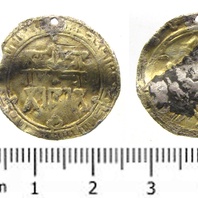
Viking Objects
Samanid Silver Dirham Pendant (LCNCC:2014.16)
An Arabic silver dirham minted c. 905-906 (Hijra 293) for the Samanid ruler, Isma’il ibn Ahmad (849-907), that has subsequently been pierced and gilded so that it could be worn as a pendant. It was probably minted in Balkh, Afghanistan. The Vikings often repurposed items like this. The dirham was a unit of weight used across North Africa, the Middle East, and Persia, with varying values which also referred to the type of coins used in the Middle East during the Viking Age. These coins were extremely prized possessions not only for their silver value but as a way of displaying one’s wealth and vast trade connections. Millions of Arabic dirhams would have been imported throughout the Viking world and are mostly found in hoards.
Read More
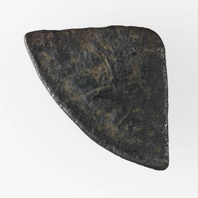
Viking Objects
Unprovenanced Abbasid Silver Dirham (CM_1777_2008)
It is unknown for which ruler this dirham was minted nor where the mint was located. However, it has been speculated that the mint would have been located somewhere in Iraq, Iran, or Central Asia. The dirham was a unit of weight used across North Africa, the Middle East, and Persia, with varying values which also referred to the type of coins used in the Middle East during the Viking Age. These coins were extremely prized possessions not only for their silver value but as a way of displaying one’s wealth and vast trade connections. Millions of Arabic dirhams would have been imported throughout the Viking world and are mostly found in hoards. It is thought that one cause of the Viking Age was a reduction in access to Arabic silver.
Read More
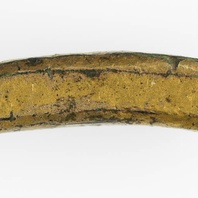
Viking Objects
Forged Hack-gold Rod (CM 595-2010)
This forged hack-gold rod comprises a curved section of gilt copper-alloy. It is square in cross-section and is broken at both ends. It shows that someone near Torksey was trying to con others by passing copper-alloy as gold. Like hacksilver, hack-gold was used to pay for items by weight of precious metal. The buyer and seller would agree the value of an item and pieces of silver or gold would have been cut up and weight out until the right amount had been paid. Gold was much less common among the Vikings than silver.
Read More
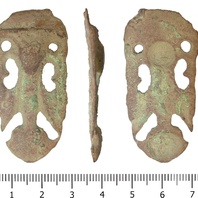
Viking Objects
Tongue-Shaped Strap-End (DENO-1268B3)
An incomplete, copper-alloy strap-end with anthropomorphic designs. These types of strap-ends were popular in both Scandinavia and on the Carolingian continent between the 9th and 10th centuries and were regularly used to embellish baldrics. Strap-ends came in various styles and were fairly common throughout the Viking world. They were used to decorate the ends of belts and to stop them getting damaged.
Read More
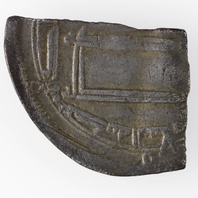
Viking Objects
Abbasid Silver Dirham (CM_773_2008)
This coin was minted at al-‘Abbasiyya. The dirham was a unit of weight used across North Africa, the Middle East, and Persia, with varying values which also referred to the type of coins used in the Middle East during the Viking Age. These coins were extremely prized possessions not only for their silver value but as a way of displaying ones wealth and vast trade connections. Millions of Arabic Dirhams would have been imported throughout the Viking world and are mostly found in hoards. Reduction in access to silver coins like this is thought to have been one of the causes of the Viking Age.
Read More
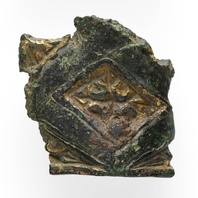
Viking Objects
Broken Gilt Vessel (CM.1822.2008)
A broken gilt vessel fragment decorated with a Carolingian motif within a repeated diamond pattern. A single iron rivet provides evidence that this vessel might have been repaired and reused. The vessel will have been brought from Francia to Torksey, Lincolnshire, where it was found, perhaps by a member of the Great Heathen Army or its train.
Read More
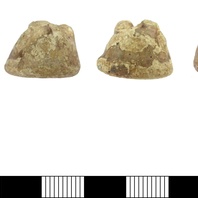
Viking Objects
Cast Lead-Alloy Gaming Piece (DENO-646EE0)
A complete cast lead-alloy early medieval gaming piece. This and similar pieces have also been interpreted as weights although the gaming piece interpretation is more secure. Pieces like this would have been used to play hnefatafl and/or Nine Men’s Morris, both of which are known to have been played in Scandinavia in the Viking Age.
Read More
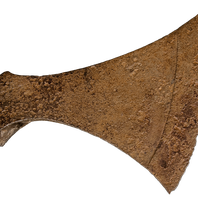
Viking Objects
Socketed Axe (LCNCC:1906.9661.2)
This large socketed iron axe head was found in the River Witham, east of Lincoln, Lincolnshire. Axes were not only a common implement used for a variety of wood-based activities, such as constructing ships, but also were often used as weapons. Axes came in a variety of shapes and sizes depending on their function. Considering the size and shape, this axe was most likely used for warfare rather than as a tool.
Read More
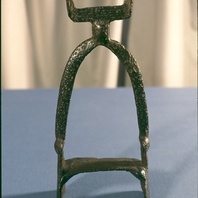
Viking Objects
Stirrup (LCNCC : 1906.9663)
A large iron stirrup of Viking type with a long slender looped form, rectangular terminal, and a flat footrest. It was found in the River Witham near Lincoln. Stirrups like this were an innovation that Scandinavian settlers introduced to Anglo-Saxon England in the eleventh century.
